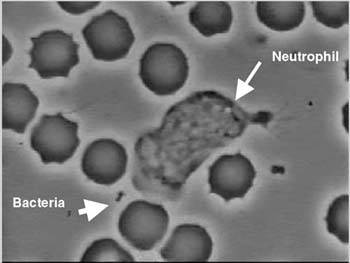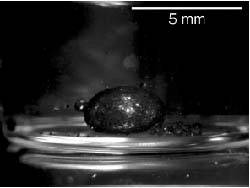Emergent Systems
| A human cell serves as a culmination of what nature has taken millions of years to evolve: an autonomously responsive system of sensors and actuators that operates based on commands from an embedded and distributed intelligence. It is a self-regulating, self-governing unit, with its nucleus serving as its central information processor, and hence it represents a system based on the fusion of a number of factors. The transfer and transduction of information using various signal pathways found in cells serve to process and apportion this information to induce a concerted action. For example, a chemical signal results in a sensory response that elicits mechanical movement or actuation from the cytoskeletal networkall characteristic behavior in chemotaxis, or chemical-induced cellular movement. As a composite system, a cell exemplifies the concept of emergence, where inputs result in coordinated feedback. The example of a neutrophil hunting down and encircling the Staphylococcus aureus bacterium (Figure 17-7) demonstrates concerted, self-determining behavior. The bacterium emits a chemical gradient that is sensed by a cell. The cell, which is able to follow a complex path of the chemical, moves toward the bacterium and eventually surrounds the bacterium to envelope, or phagocytoses, it. In this process, the chemical is sensed by the chemical sensors inside the neutrophil and is processed by the signal pathways. Eventually, the neutrophil acts as a whole to capture the bacterium. Figure 17-7. A neutrophil is observed chasing a Staphylococcus aureus bacterium. The bacterium emits a chemical that is in turn sensed by the neutrophil, which then coordinates an autonomous actuation directed toward the phagocytosis of the bacterium (Rogers et al. 1950). A key element of manufacturing large-scale molecular systems will be the derivation of emergence, or true mimicry, toward applications in energy production, nanoscale medicine, and so on. Continued progress in nanotechnological development will result in promising approaches whereby the input of stimuli (such as light, reactive chemicals, and so on) induces systemic behavior not previously present to produce emergent behavior. Showing particular promise are micrometer-sized photonic crystals of porous silicon presented by Link and Sailor (2003). The optical properties of these crystals change upon the absorption of chemicals, the fabrication of which is illustrated in Figure 17-8. Figure 17-8. Surrounding of dichloromethane drop by self-orienting, self-assembling "smart dust" particles. This is accomplished through hydrophobic-hydrophobic interaction between the dichloromethane and the hydrophobic porous silicon (Link et al. 2003). The "smart dust" particles are composed of two sides: a green, "water-fearing" (hydrophobic) side, and a red, "water-loving" (hydrophilic) side. Furthermore, because of their amphiphilic nature, the smart dust particles will orient themselves spontaneously at a water surface to form a monolayer so that the hydrophilic side faces the water and the hydrophobic side faces the air. If porous silicon particles are incubated in water with a drop of dicholoromethane solvent, the smart dust particles will self-assemble and orient themselves around the drop of dichloromethane so that the hydrophilic side (red) faces the water and the hydrophobic side faces the solvent drop, as shown in Figure 17-8. The individual particles aggregate together to form a large, macroscopic collection that emerges as a result of the particle self-assembly. As demonstrated by Link and Sailor, the smart dust particles prove useful in the detection of a chemical such as dichloromethane. The modification of the particles with recognition elements may add further use to the particles by facilitating the detection and isolation of pathogenic organisms in food or water. Beyond the practical application of this work to detection and similar uses, a compelling approach to deriving an intrinsic, higher-order behavior from the system has been established. This was accomplished through the addition of a new condition to the solution, represented by the drop of dichloromethane. We are currently at a burgeoning stage with respect to the development of emergent behavior in artificial systems, and continued efforts will seek to embed increased quantities of information in artificial systems to derive even more complex higher-order functionality, such as usable energy or other coordinated activity. The push toward true fusion will inevitably arrive at the achievement of true mimicry. This will be an essential precursor to realizing the human benefit of nanotechnology. |
EAN: 2147483647
Pages: 204

